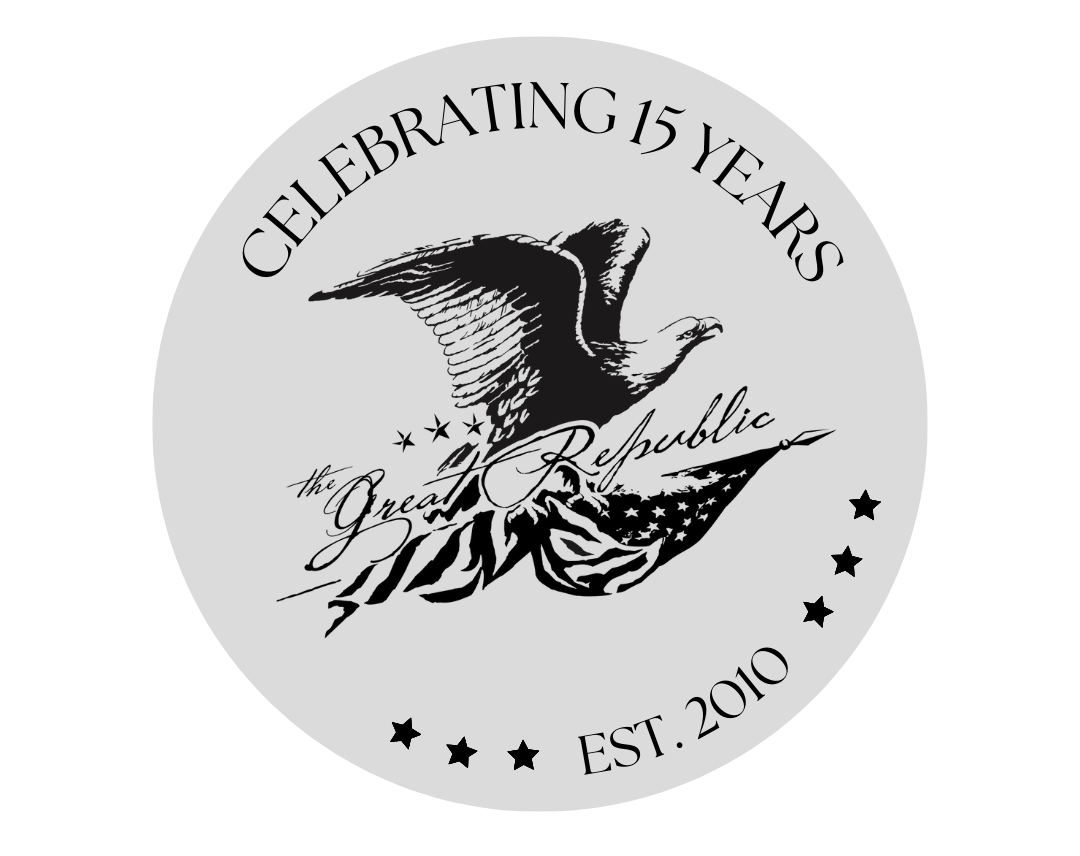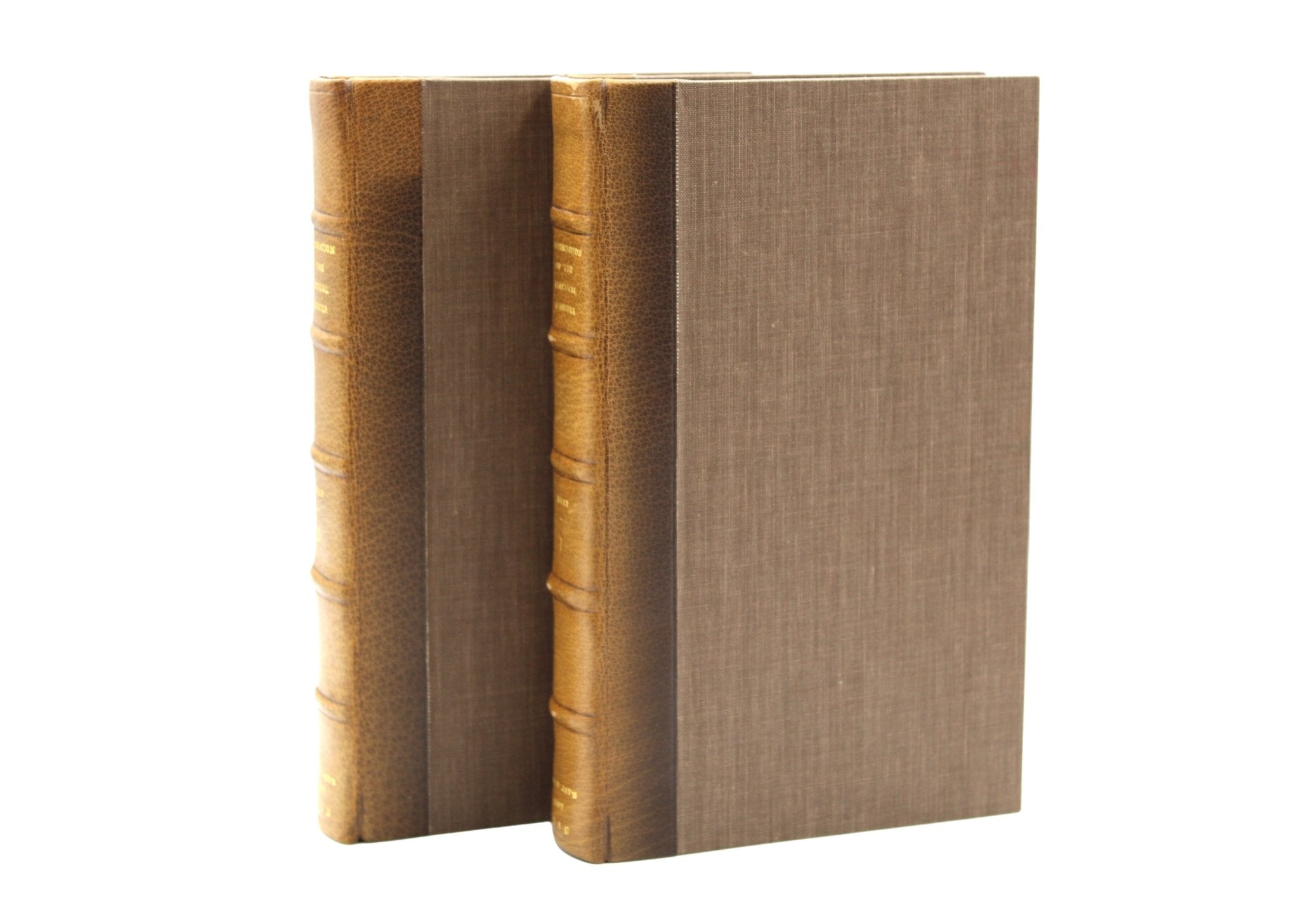
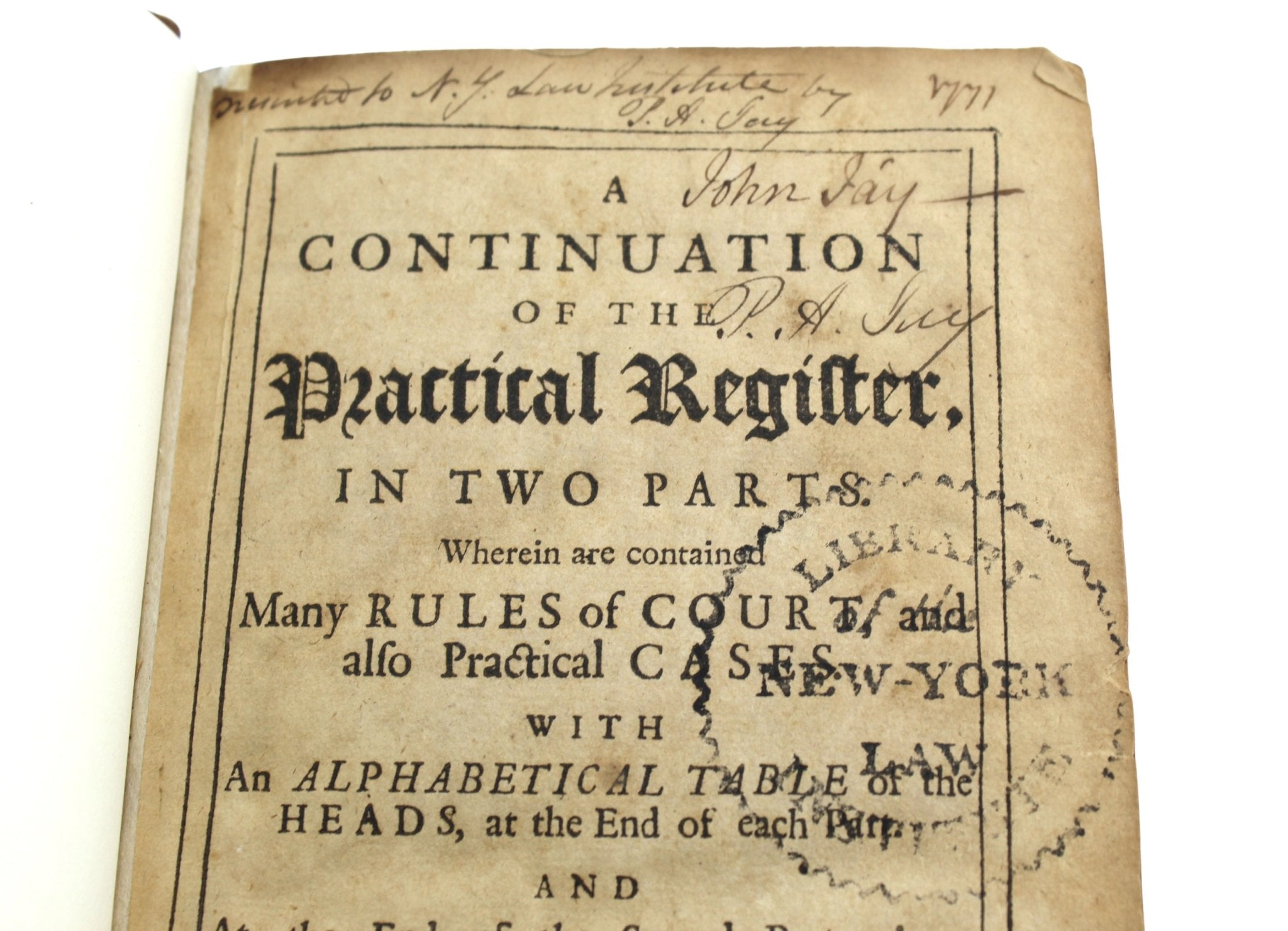

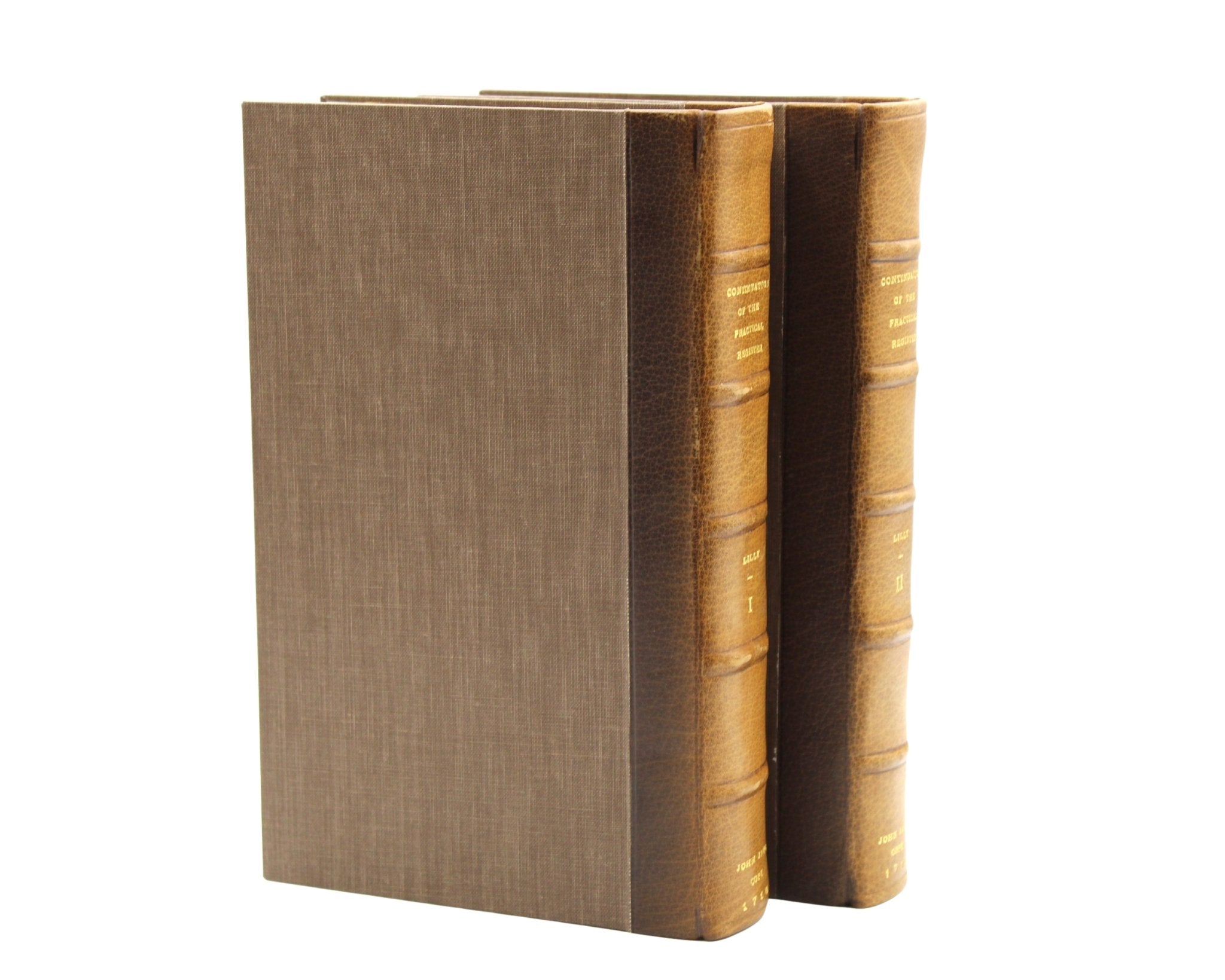
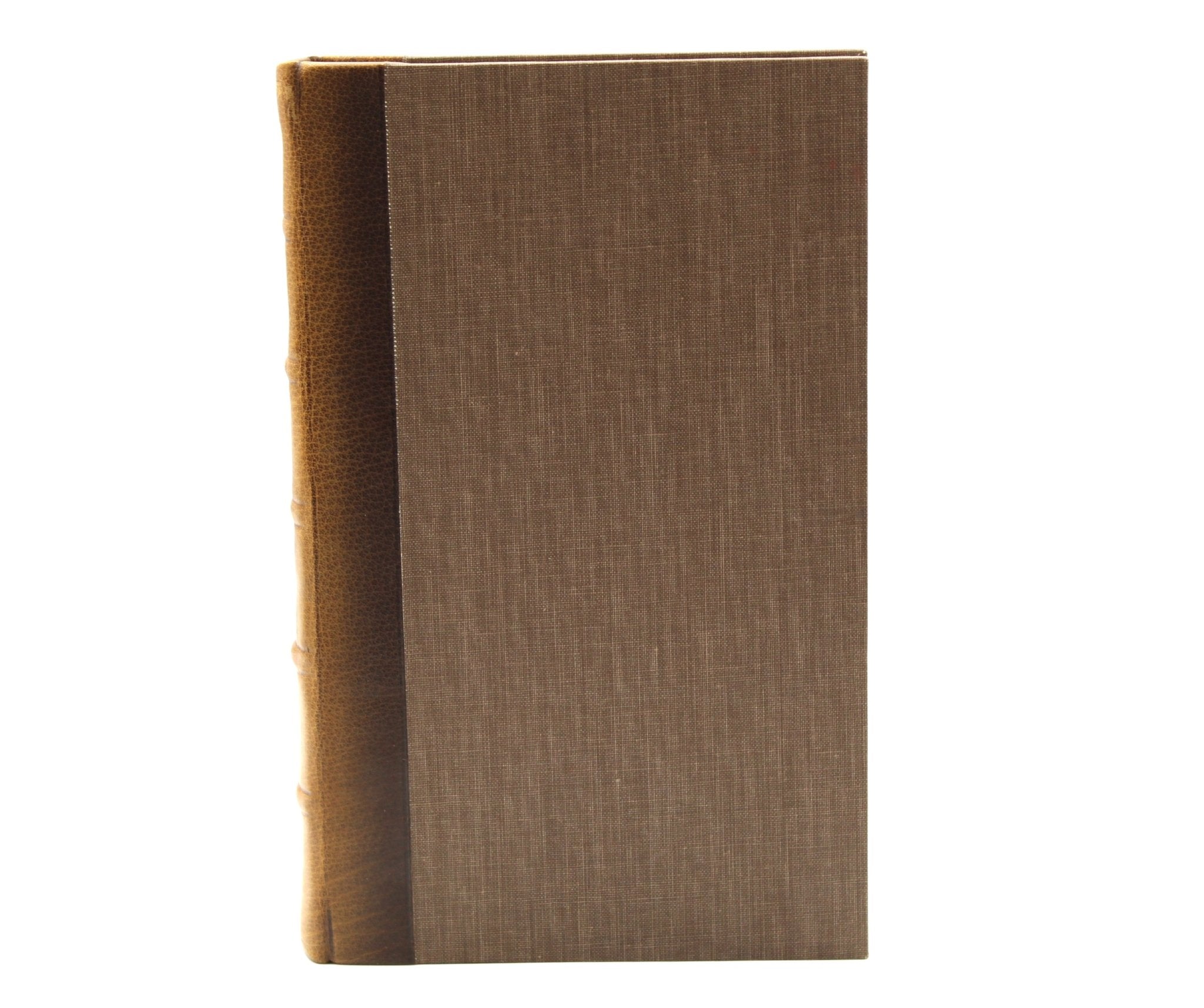
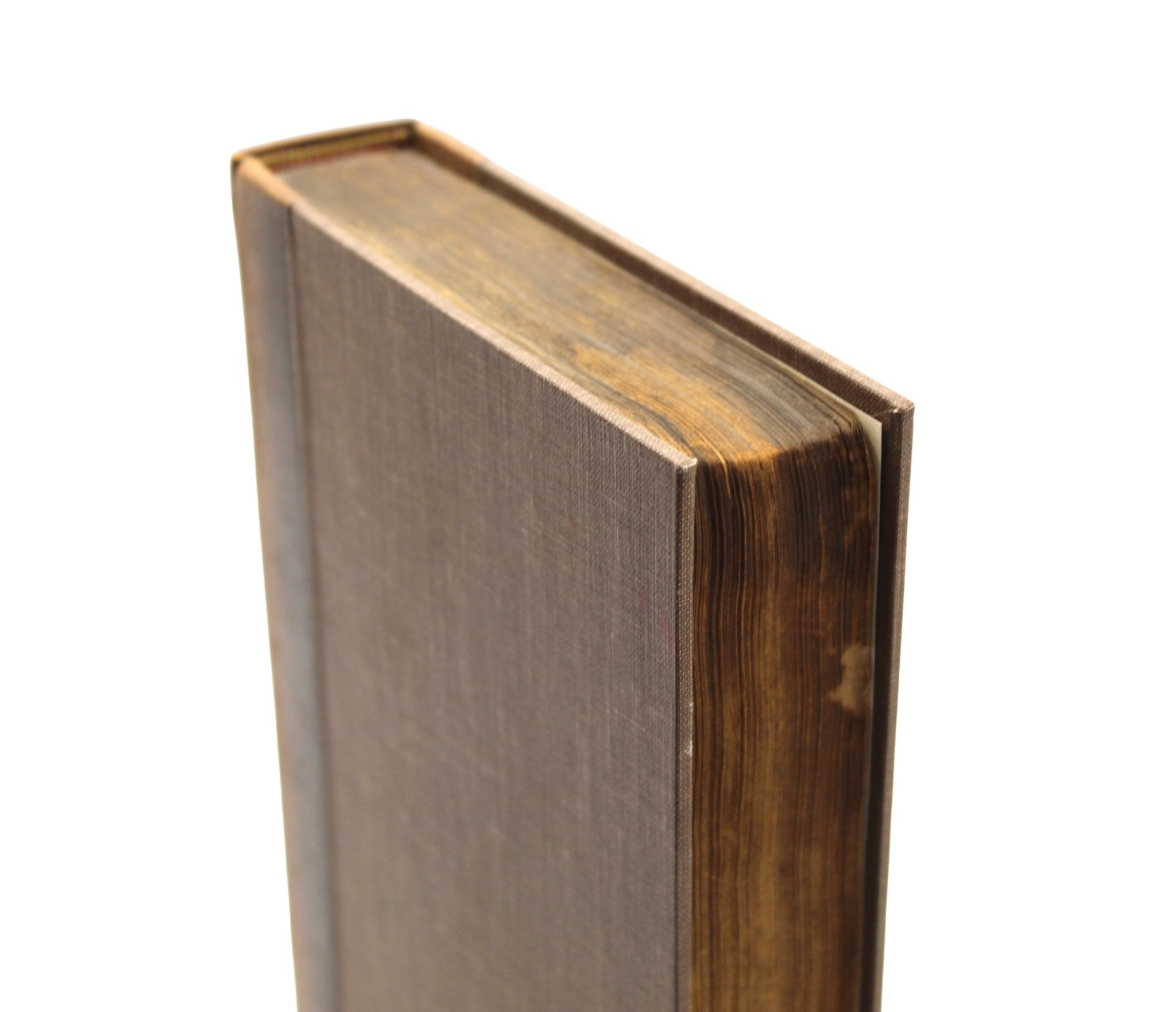


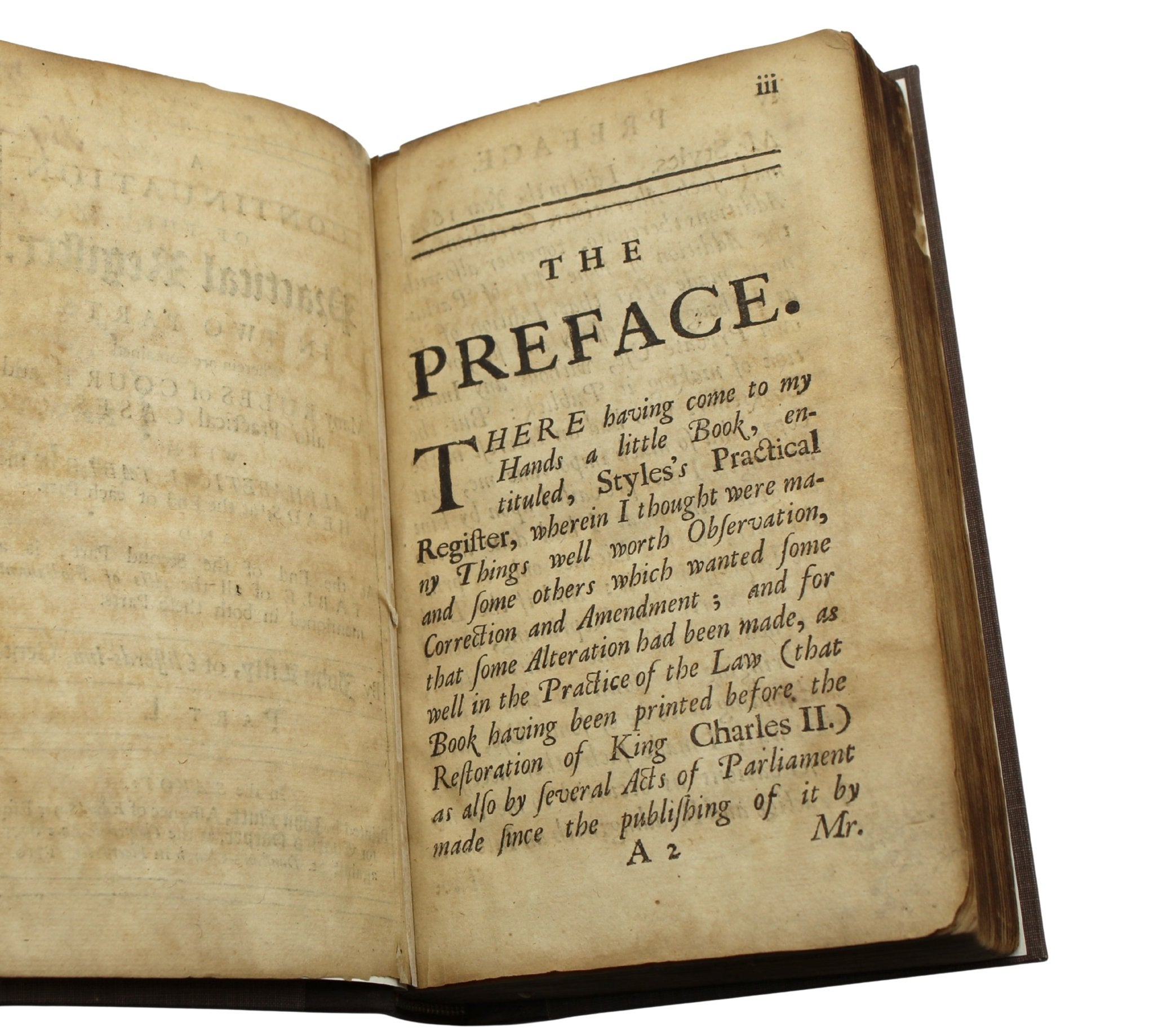
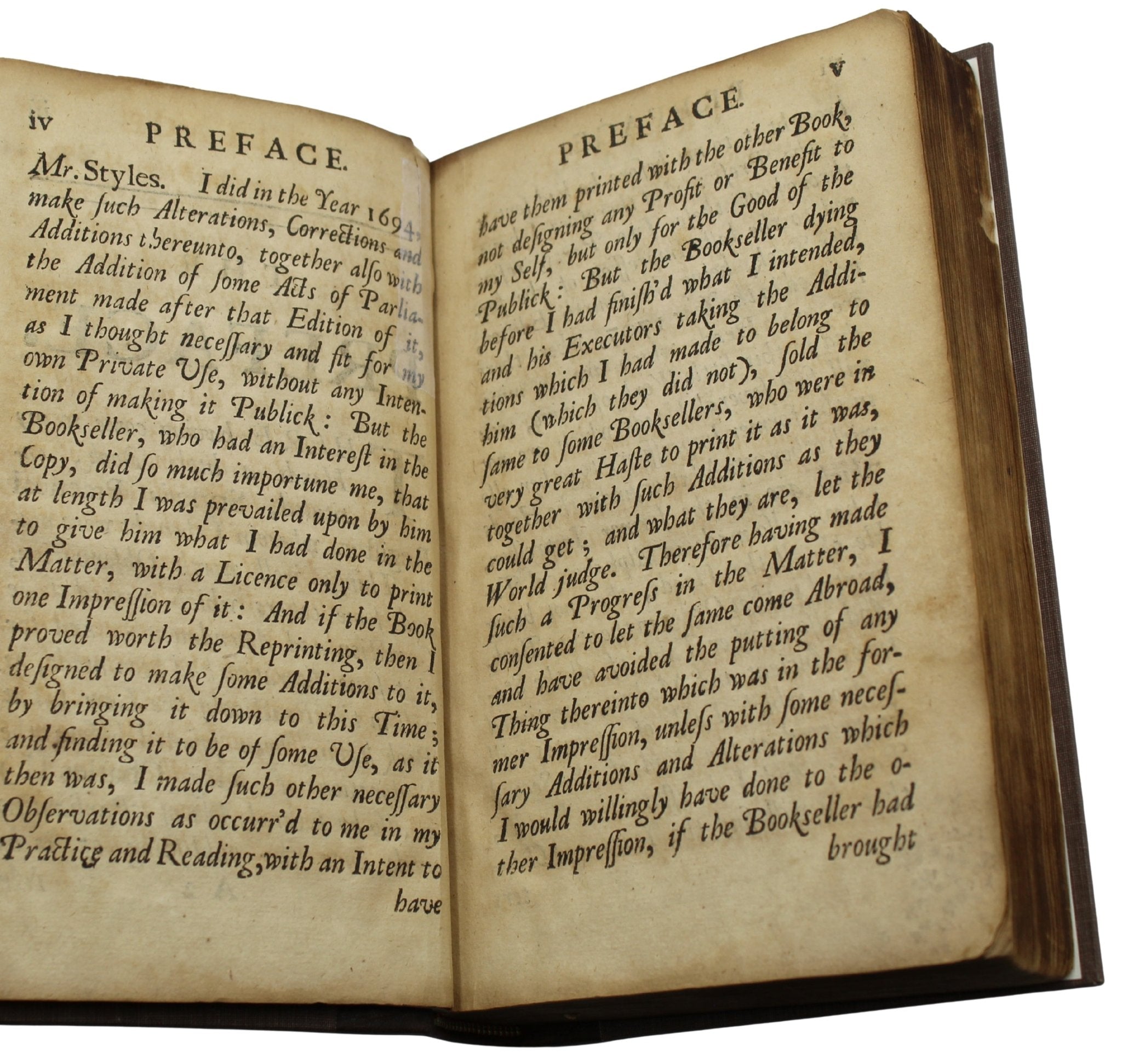
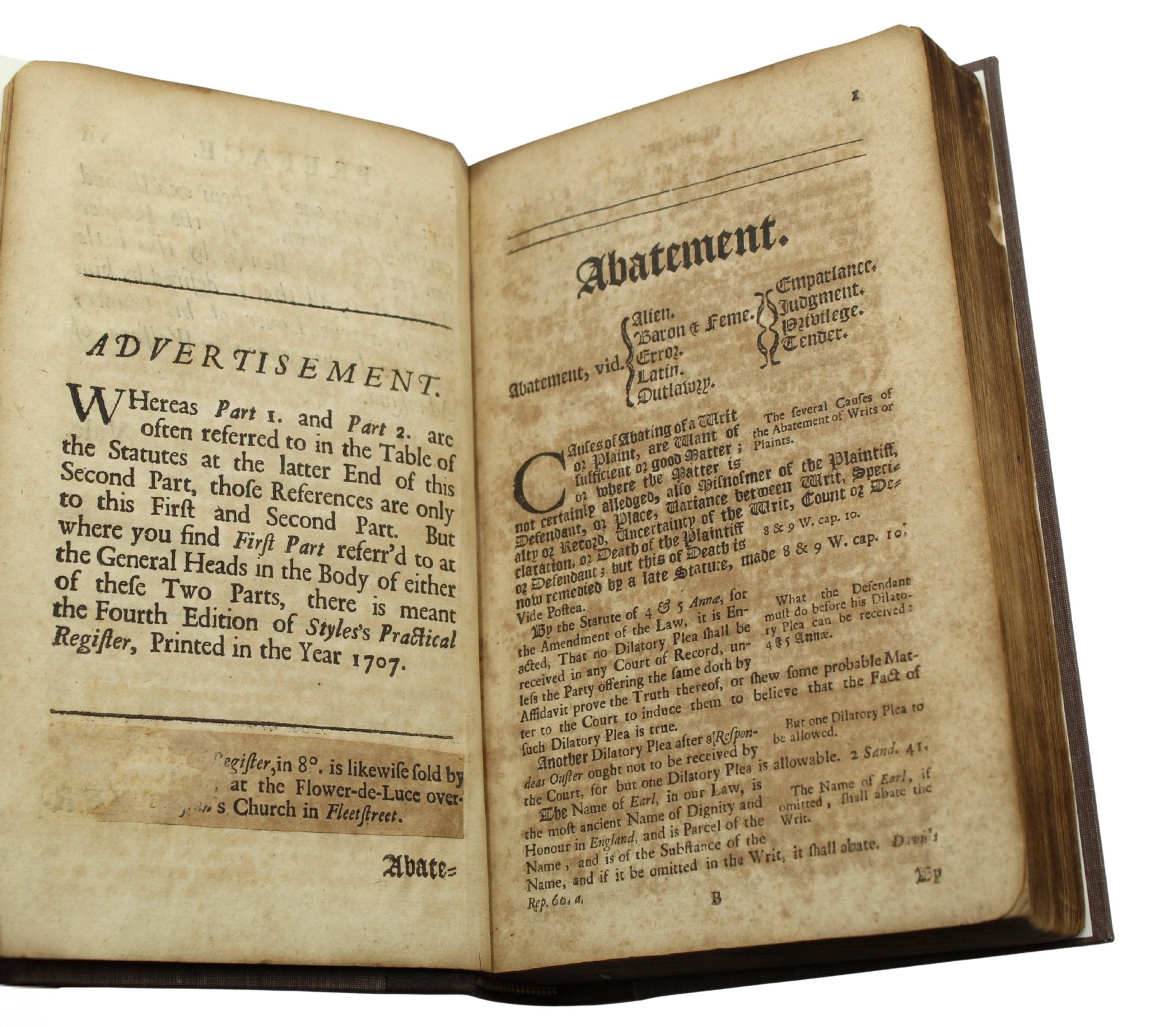
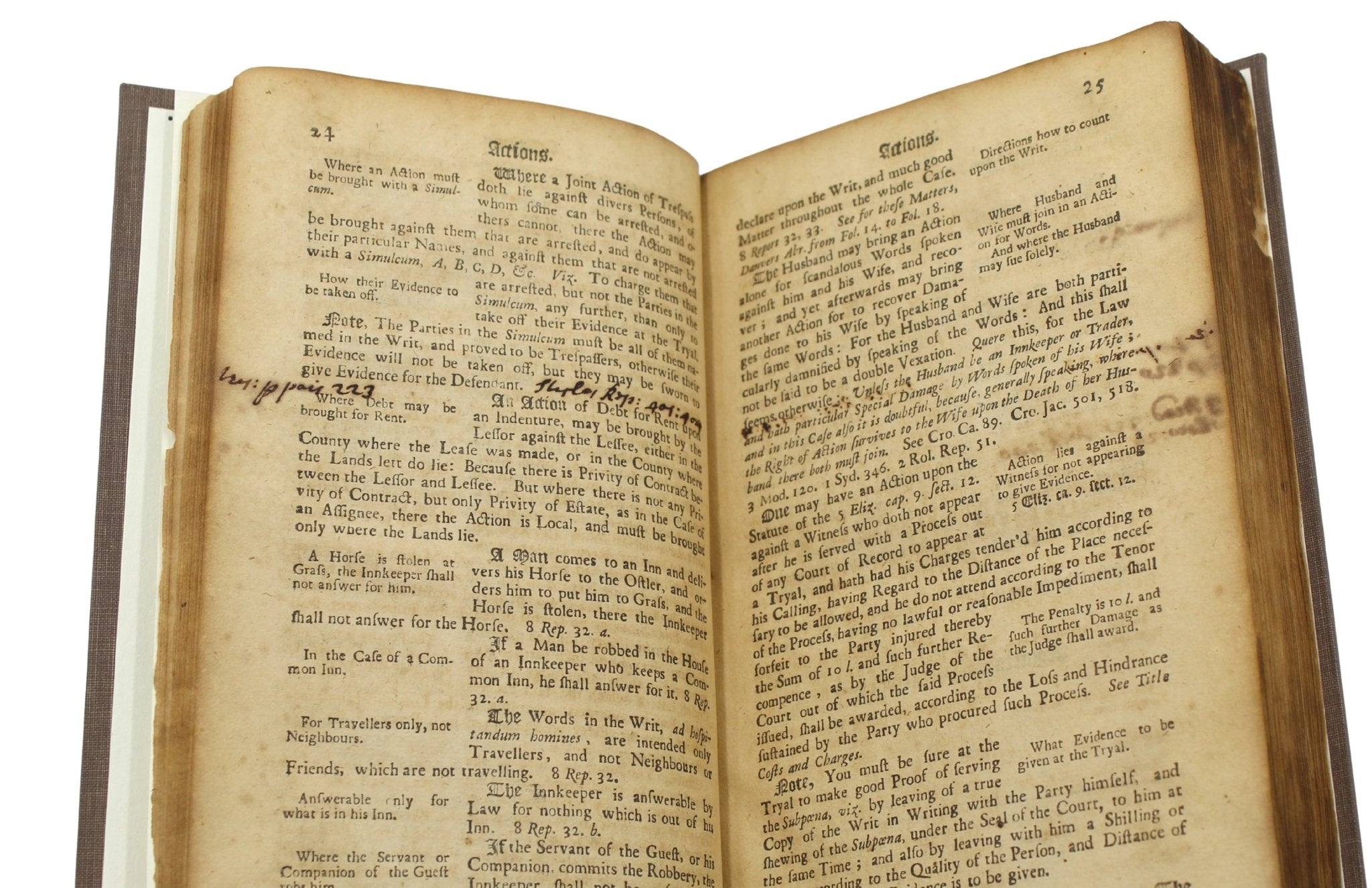
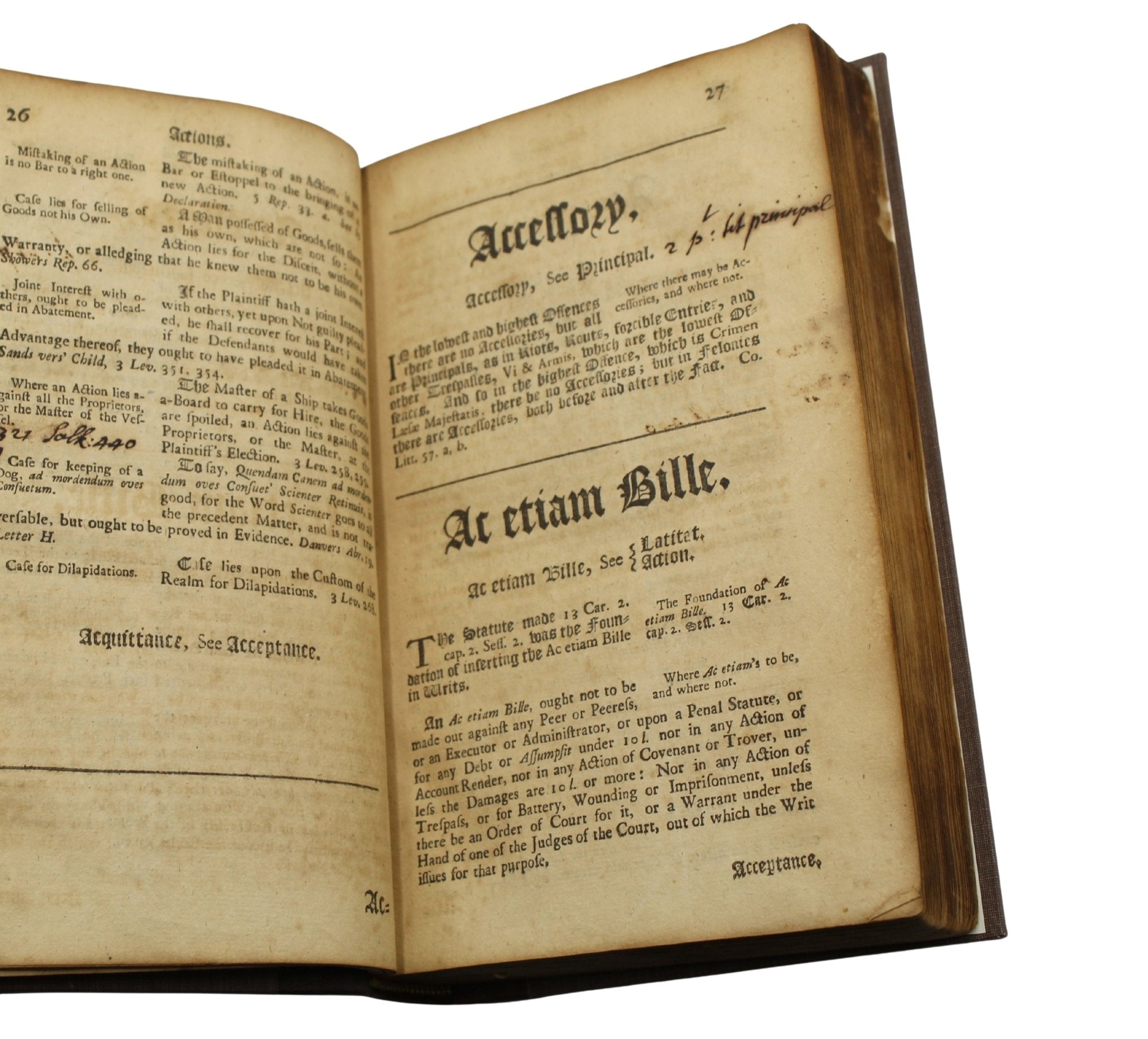
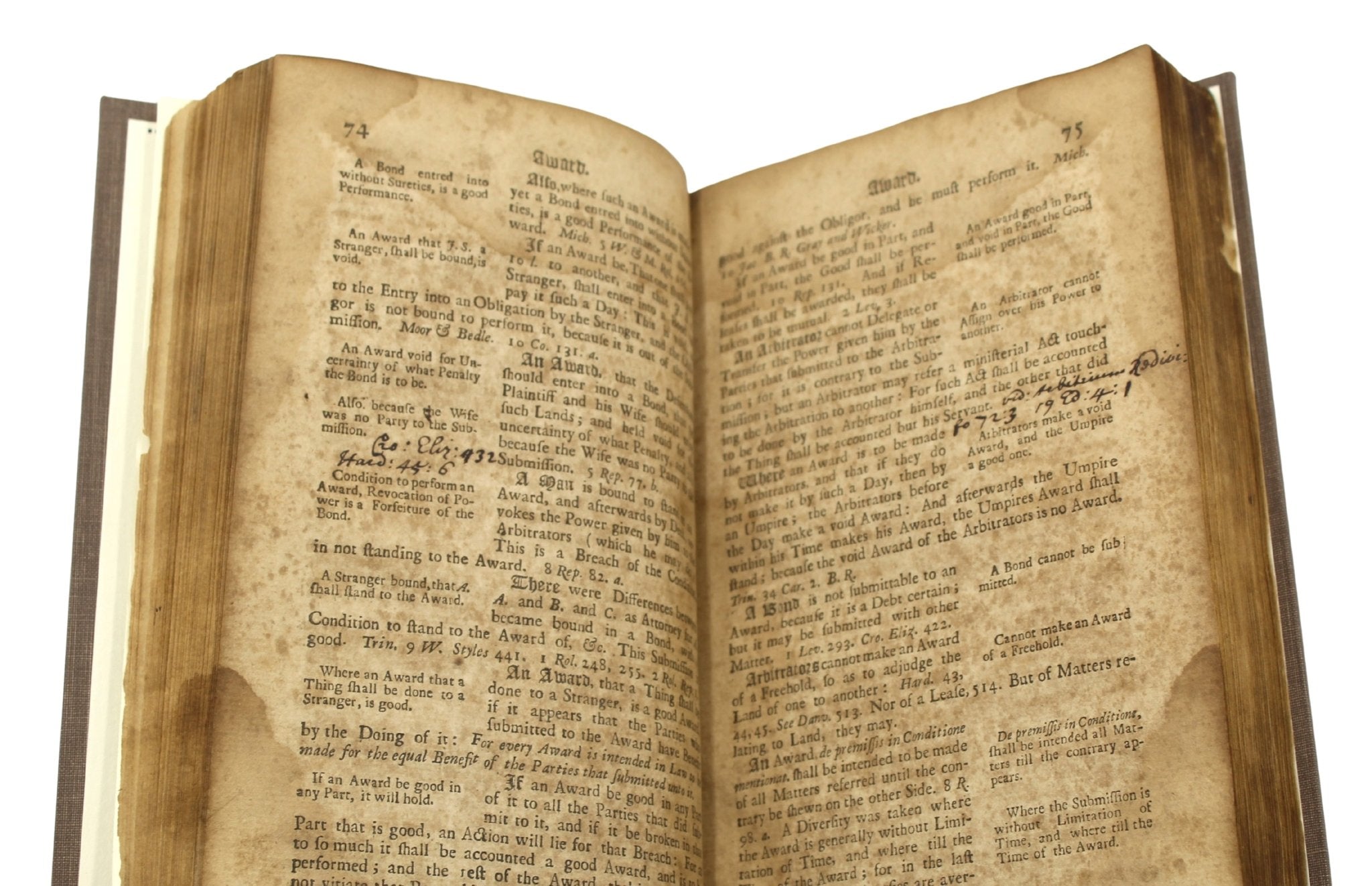
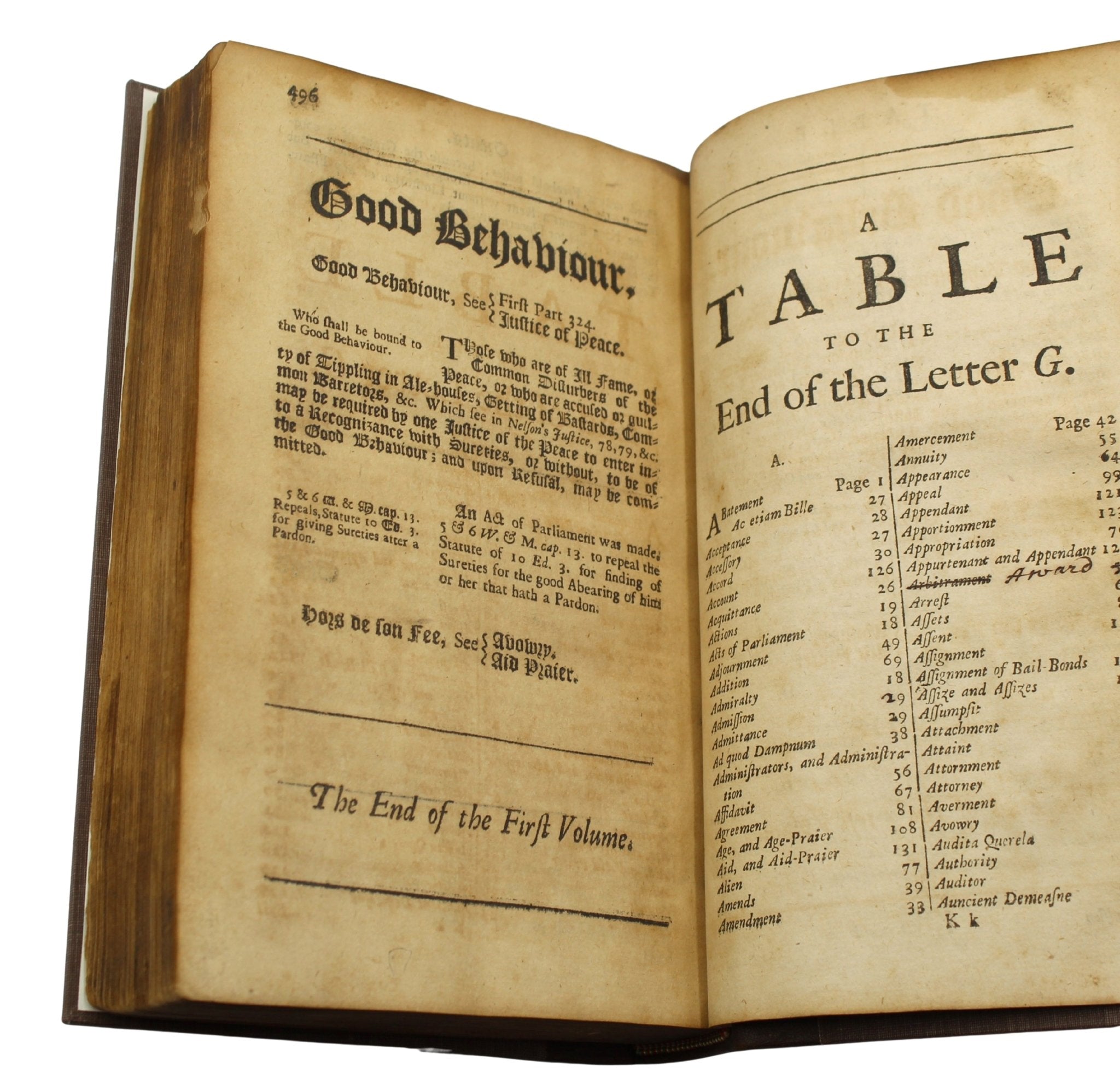
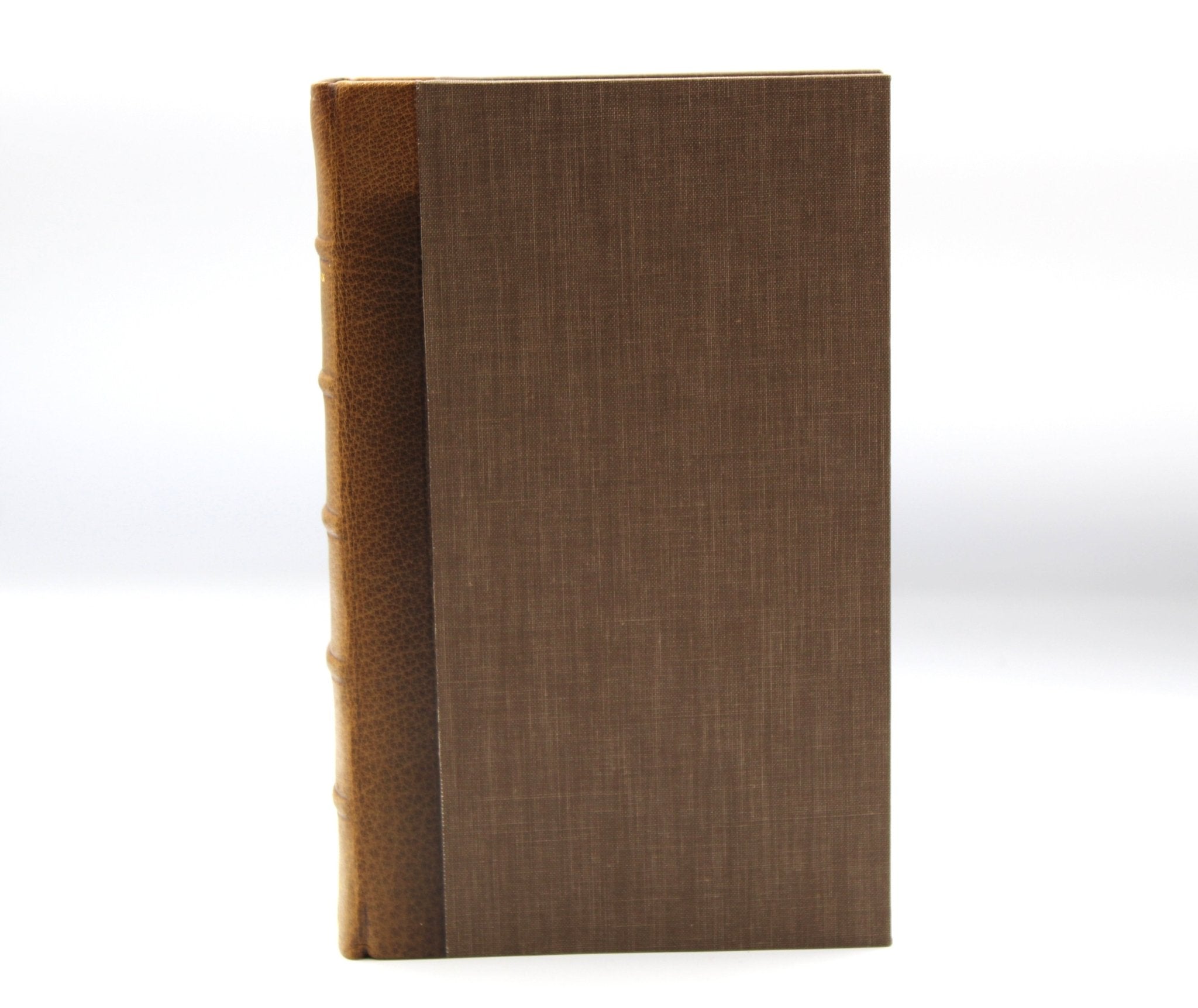
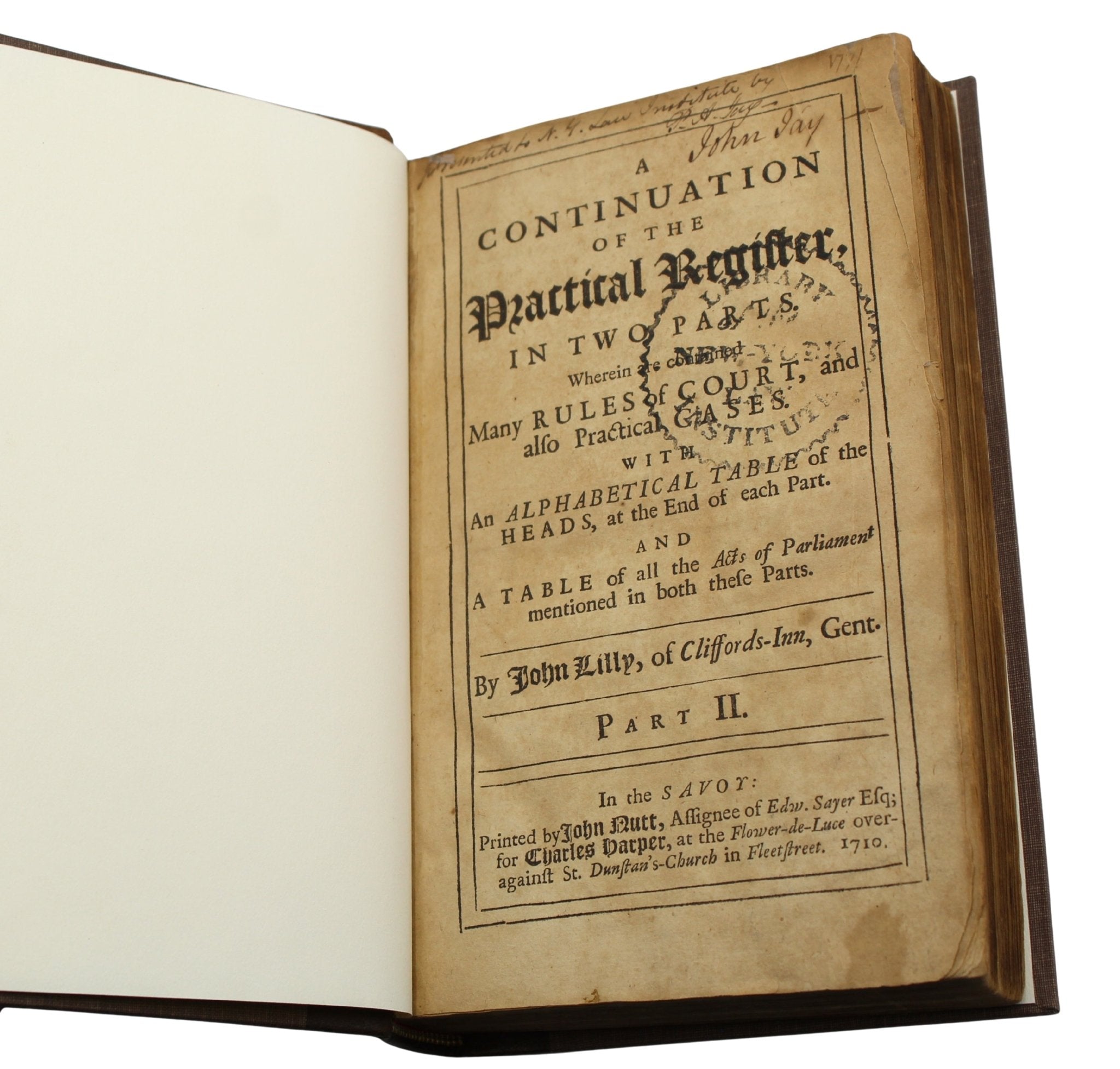
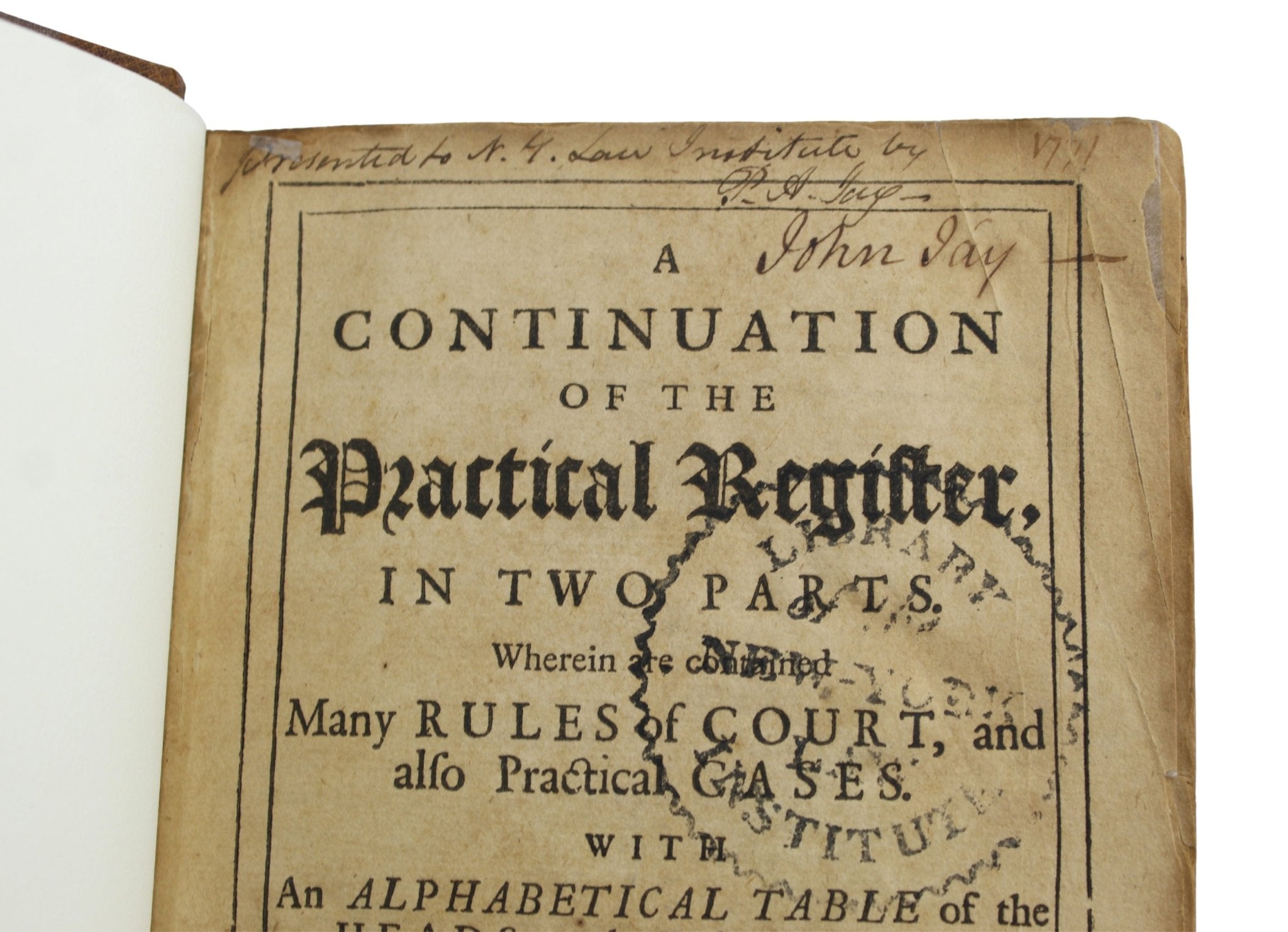
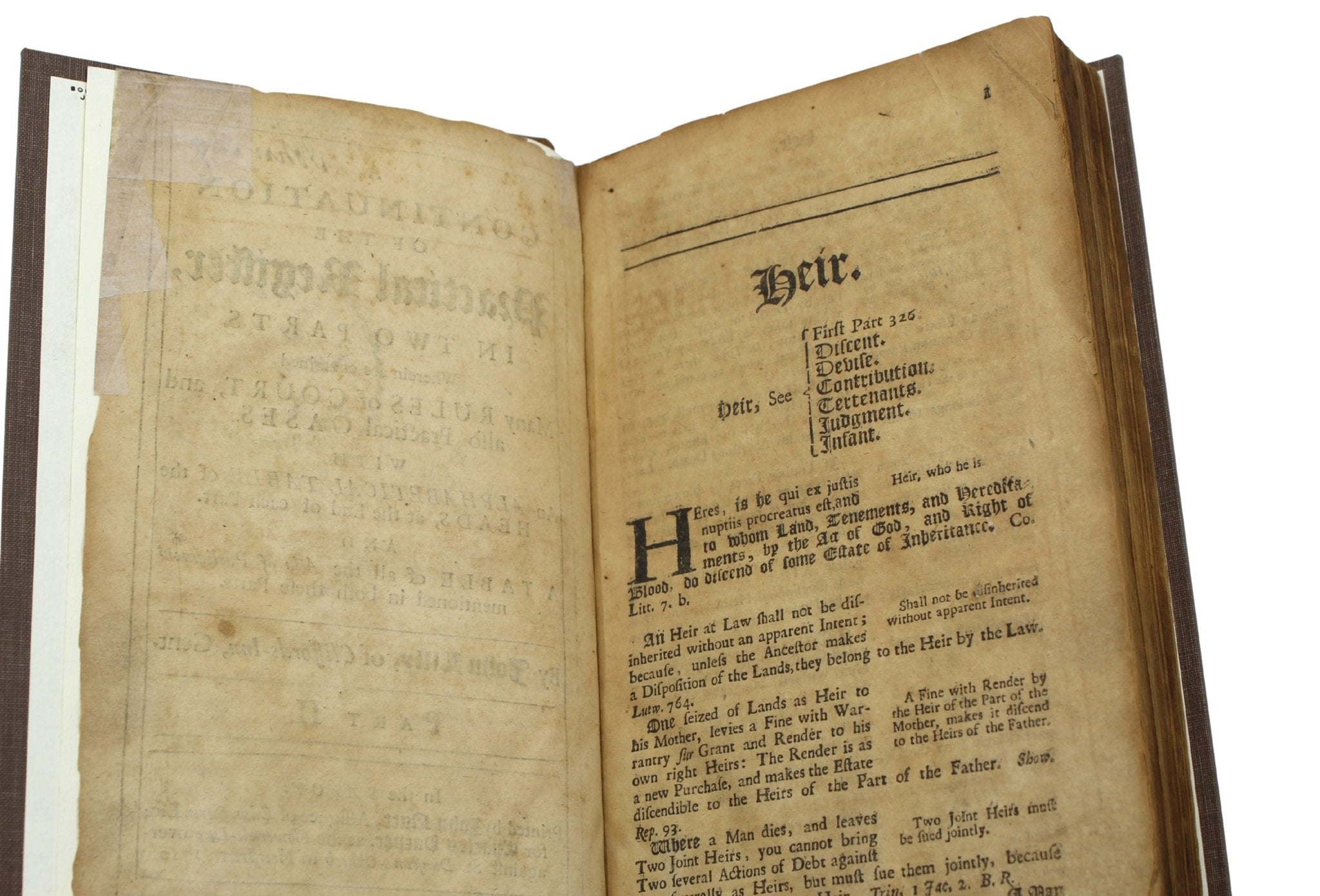
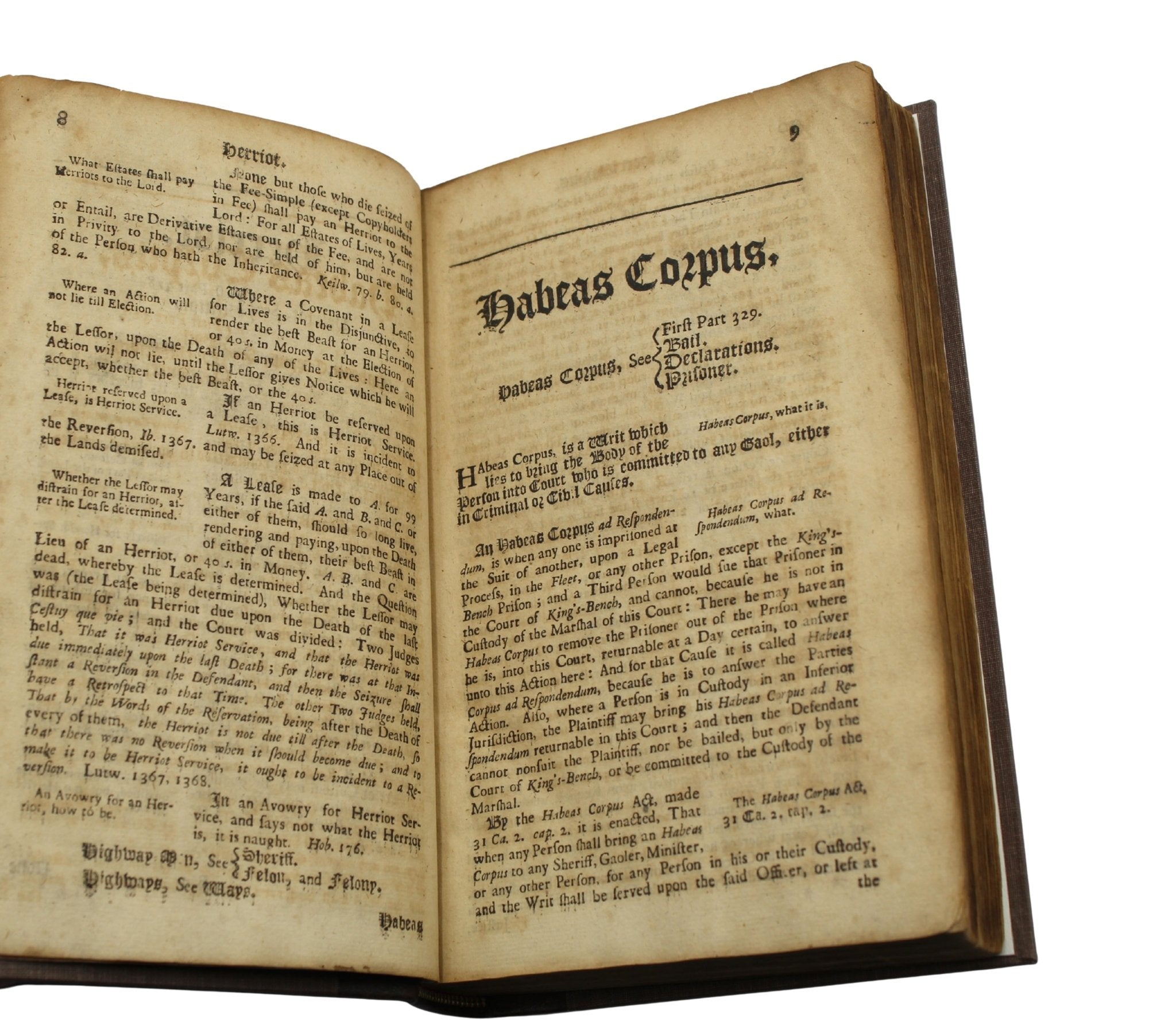
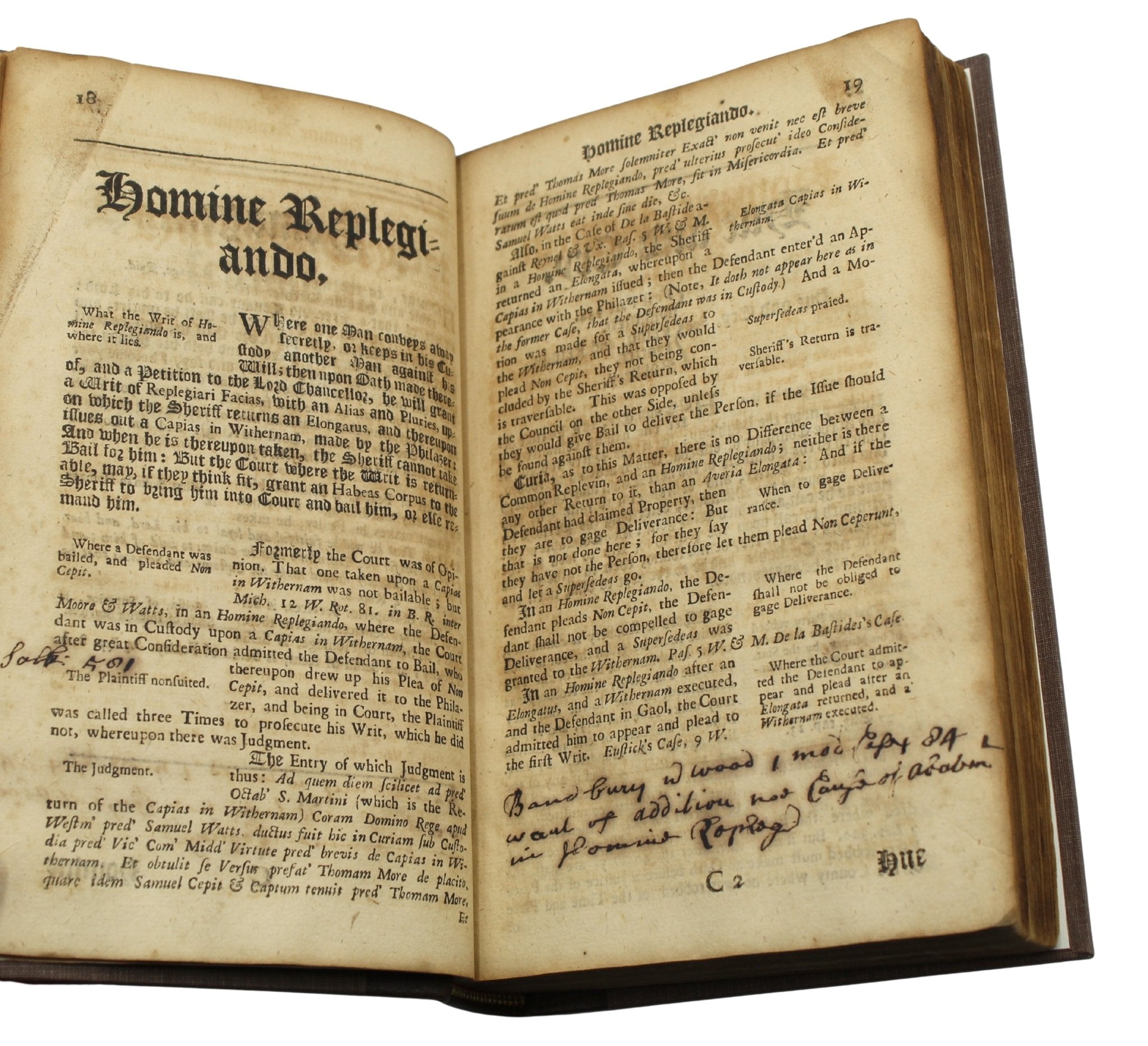
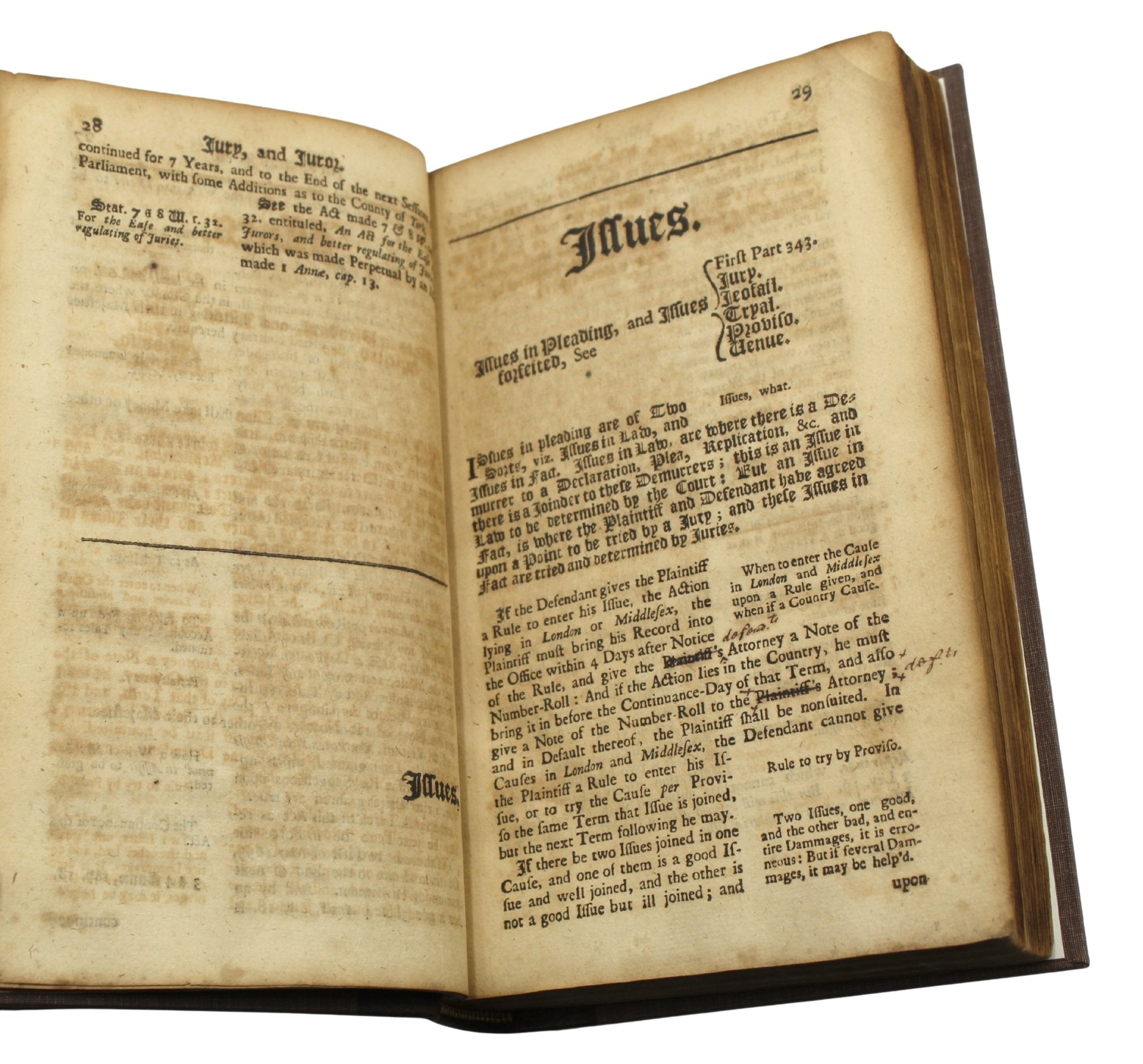
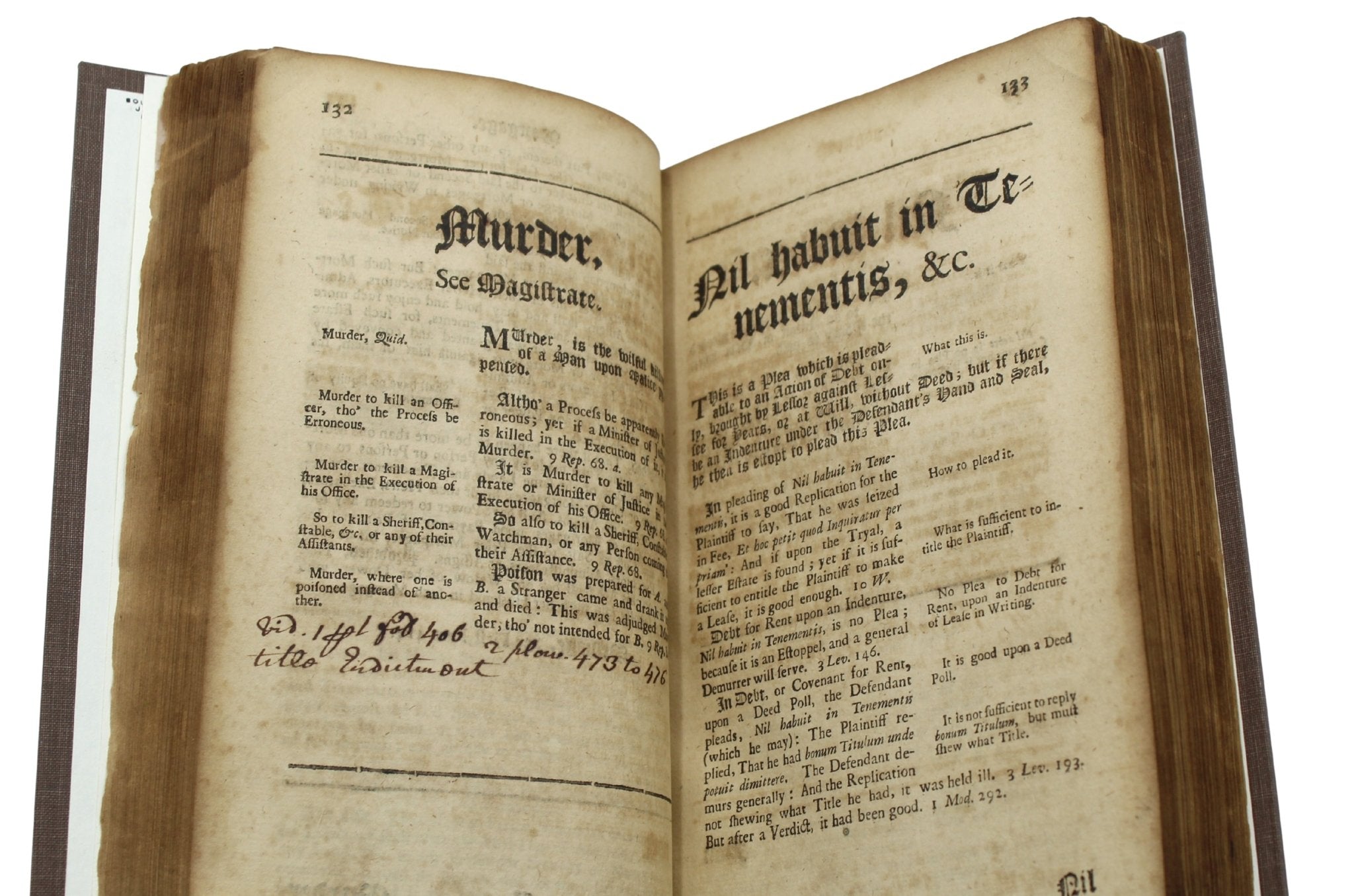
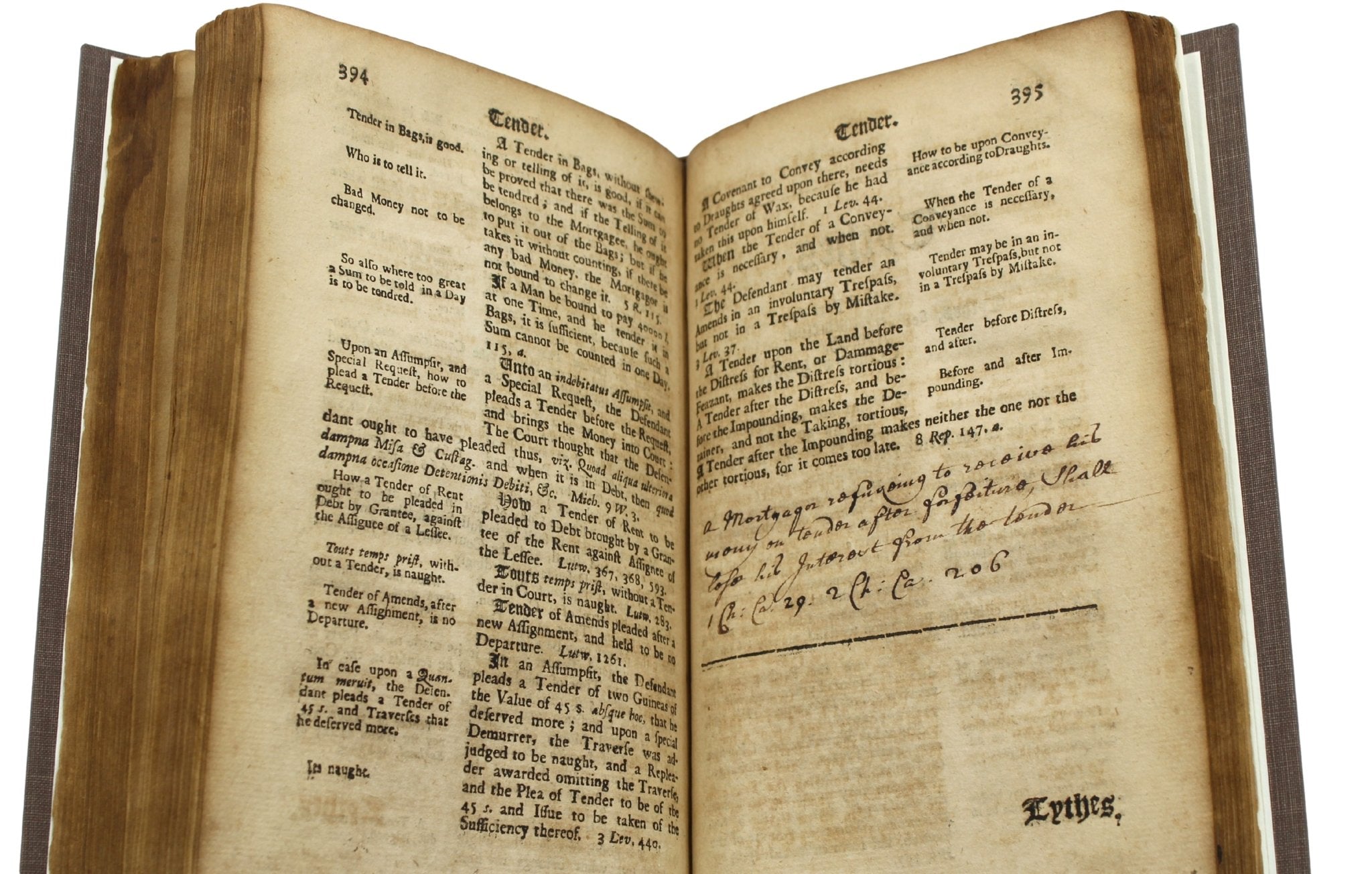
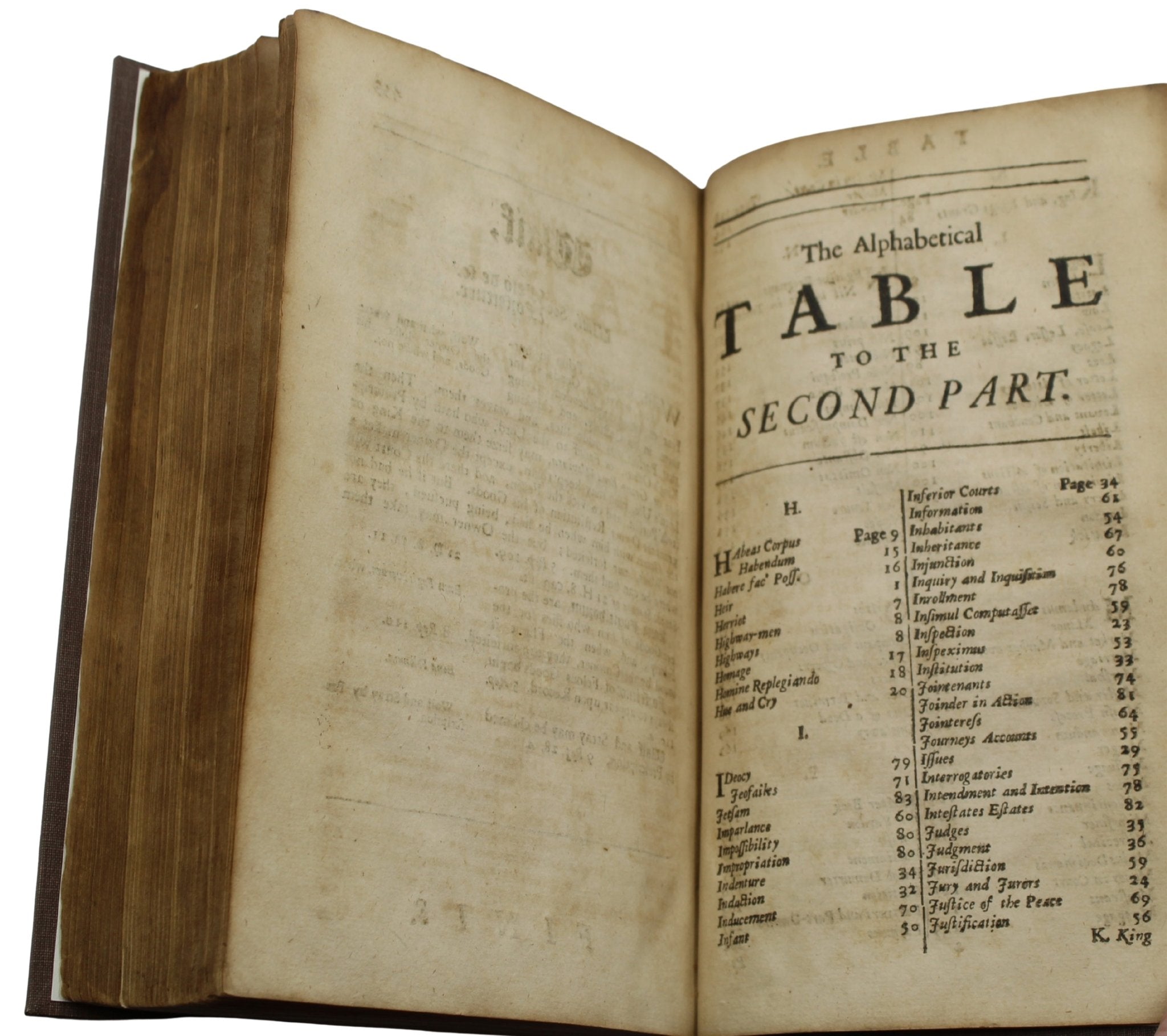
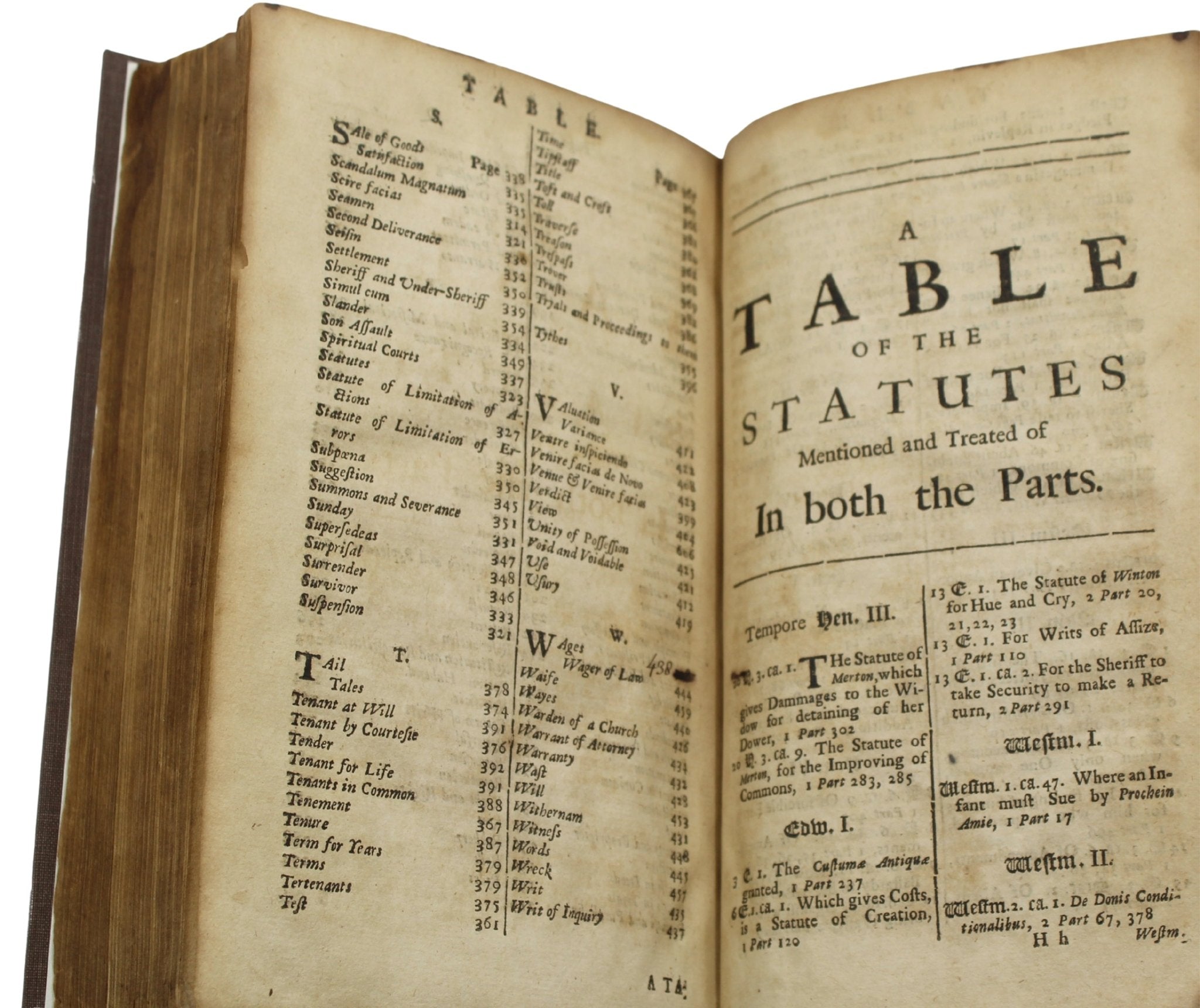
John Jay's Signed Copy of A Continuation of the Practical Register, In Two Parts, by John Lilly, 1710
Lilly, John. A Continuation of the Practical Register, In Two Parts. Wherein are contained Many Rules of Court, and also Practical Cases. London: John Nutt for Charles Harper, 1710. In two volumes. Rebound in ¼ brown leather and beige cloth boards. Signed by John Jay, inscribed by Peter Augustus Jay, on the title pages. Ex-library: New York Law Institute.
From the personal library of the First Chief Justice of the United States, this is John Jay’s signed edition of the A Continuation of the Practical Register, In Two Parts. Wherein are contained Many Rules of Court, and also Practical Cases. Written by John Lilly, the book was printed in 1710 in London by John Nutt, for Charles Harper. Across the title pages of both books, in black ink, are Jay’s ownership signatures “John Jay,” as well as the date “1771,” possibly indicating when the volumes were added to Jay’s personal library. John Jay’s inked notations can be found along the margins of the text of both volumes. The volumes were later donated by John Jay's son, Peter Augustus Jay, to the library of the New York Law Institute, the oldest circulating law library in New York City.
A Continuation of the Practical Register was written as a law dictionary, providing British attorneys and clerks with an alphabetical list of actions, legal documents, and legal terms with definitions and references to related statutes and cases. Volume I begins with the term “Abatement” and continues through “Good Behavior”; Volume II begins with the term “Heir” and ends with “Writ of Inquiry.” The author, John Lilly, explains his reasoning for writing the book in his preface, “There having come to my Hands a little Book, entituled, Styles’s Practical Register, wherein I thought were many Things well worth Observation, and some others which wanted some Correction and Amendment; and for that some Alteration had been made, as well in the Practice of the Law (that Book having been printed before the Restoration of King Charles II.) as also by several Acts of Parliament made since the publishing of it by Mr. Styles.” He continues, “If the Reader can receive any Benefit by this little Work, it is all that is desired by him who is a true Lover of his Country and the Laws, and the Welfare of Mankind.”
Based on the date of 1771 by his ownership signatures, John Jay acquired these volumes a few years after he gained admission to the bar in 1768. It makes sense that Jay would have acquired and kept this British law dictionary in his personal library. In the aftermath of the American Revolution, both the individual states and the newly formed United States mitigated the necessity of drafting an entirely new legal framework by adopting British statutes and legal procedures that were compatible with the American context and not inconsistent with the Constitution. Between 1776 and 1784, eleven of the thirteen original states enacted provisions to retain the application of common law and select British statutes.
John Jay (1745–1829) was a prominent Founding Father who played key roles during both the American Revolutionary War and the early years of the United States. Born into a wealthy merchant family in New York City, Jay graduated from King’s College, now Columbia University, in 1764 and became a practicing lawyer by 1768. Initially cautious in the face of rising tensions with Britain, he gradually emerged as a strong patriot. He served in both the First and Second Continental Congresses and was an active member of the New York Committee of Correspondence. Although his duties in the New York Provincial Congress kept him from signing the Declaration of Independence, he supported its goals and helped draft New York’s first state constitution in 1777.
Jay held several influential political and judicial positions during and after the Revolution. He served as Chief Justice of New York’s Supreme Court of Judicature and later as President of the Continental Congress from December 1778 to September 1779. Appointed as minister to Spain, Jay was sent to the Spanish royal court to secure financial support for the American cause, and though rebuffed, he went on to help negotiate the 1783 Treaty of Paris, which ended the Revolutionary War. From 1784 to 1789, he served as Secretary of Foreign Affairs, and in 1788, he co-authored several of the Federalist Papers, focusing on foreign policy. He accepted George Washington’s nomination to be the first Chief Justice of the United States Supreme Court in 1789 and held that position until 1795.
In 1795, while serving as Chief Justice, Jay negotiated the controversial Jay Treaty with Britain to avert another war. Despite political backlash from the Democratic-Republicans, the treaty was ratified in the Senate. During his time in Europe, he was elected Governor of New York. He resigned from the Supreme Court to serve as governor from 1795 to 1801. After turning down further political appointments, including re-nomination to the Supreme Court and the governorship, Jay retired from public life and his remaining years on a farm in Westchester County.
CONDITION:
Very good + condition. Two volumes. Rebound in ¼ Moroccan brown leather and cream cloth boards, with raised bands and gilt titles to the spine. Browning and offsetting throughout; some dampstaining. Vol. I title page reinserted on stub; Vol. II title corner reinforced. Light paper restoration to several pages throughout each volume. Ownership signature “John Jay” and date “1771” along both title pages, in black ink. Several inked notations in the margins, in both volumes. Additional gift-inscription to the New York Law Institute by and in the hand of John Jay’s eldest son, Peter Augustus Jay, on the title page of both volumes. Several New York Law Institute Library stamps on title-pages. I:vii + 496 + 8 pp.; II:ii+460+18 pp.
Book Dimensions: Vol I: 7 13/16" H x 5" W x 1 3/8" D. Vol II: 7 13/16" H x 5" W x 1 1/4" D.
Accompanied by our company's letter of authenticity. Excluded from company promotions or sales.
Pickup available at Colorado
Usually ready in 4 hours

John Jay's Signed Copy of A Continuation of the Practical Register, In Two Parts, by John Lilly, 1710
Colorado
1 Lake Avenue
Colorado Springs CO 80906
United States
Choose options


























Frequently Asked Questions
FAQs
Yes, all of our Antiques are certified authentic. Every antique comes with a signed Letter of Authenticity that details the item’s history, its current condition including any conservation, binding, or framing work, and the item’s provenance. The Letters of Authenticity are priced valuations by our authentication specialists, who assure that items are original and unconditionally guaranteed as genuine for life.
We pack and ship your items from our gallery in Colorado Springs. You may also choose to come pick up your order. Antique items are carefully packed and insured during shipping. The shipping price will be calculated at checkout.
We acquire from a variety of trusted sources all over the world, but mostly through auctions and private collections within the United States. All provenance information will be listed on the Letter of
Authenticity accompanying your purchase.

